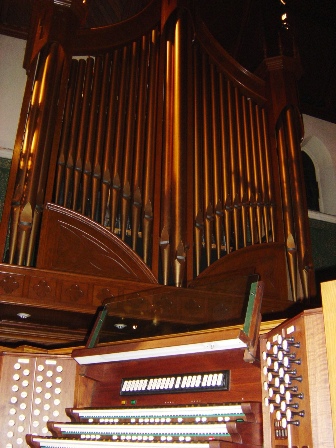|
The Cathedral Church of the Nativity Bethlehem, PA Austin Organs, Inc. Opus 2776 - 1998 3 Manuals, 47 Ranks, 9 Digital Voices |

|
|
The Cathedral Church of the Nativity Bethlehem, PA Austin Organs, Inc. Opus 2776 - 1998 3 Manuals, 47 Ranks, 9 Digital Voices |

|
| Great | Swell | ||
|---|---|---|---|
| 16' | Violone + | 8' | Montre |
| 8' | Open Diapason | 8' | Bourdon en Bois |
| 8' | Spitzflute | 8' | Viole de Gambe * |
| 8' | Dulciana + | 8' | Viole Celeste * |
| 4' | Octave | 8' | Erzhaler * |
| 4' | Nachthorn | 8' | Erzhaler Celeste * |
| 2' | Italian Principal | 4' | Prestant |
| 1 1/3' | Larigot + | 4' | Flute a Fuseau |
| Fourniture (19.22.26.29) IV | 2 2/3' | Nasard | |
| Cymbal (33.36) II | 2' | Flute a Bec | |
| 16' | Trombone + | 1 3/5' | Tierce |
| 8' | Trumpet + | Plein Jeu (15.19.22.26) IV | |
| Tremulent | 16' | Basson | |
| 8' | Trompette | ||
| 8' | Voix Humaine * | ||
| Tremulant | |||
| Solo | Pedal | ||
| 8' | Chorus V (1.8.15.19.22) + | 32' | Contra Bourdon + |
| 8' | Flute Harmonique | 16' | Open Wood * |
| Mounted Cornet V | 16' | Principal * | |
| 8' | Orchestral Clarinet * | 16' | Subbass + |
| 8' | French Horn (Heavy Wind) * | 16' | Gedackt * |
| 8' | Tuba Magna (Heavy Wind) | 8' | Octave |
| 8' | Bassflute * | ||
| Zimbelstern | 4' | Choral Bass | |
| Mixture (12.15.19.22) IV | |||
| 32' | Contre Bombarde + | ||
| 16' | Bombarde | ||
| 16' | Fagot | ||
| 8' | Trompette | ||
| 4' | Clairon |
The earliest remembrances of an organ was a Durner (we believe) and it was stuck in the back of the old church. The next organ in the church was a Johnson - again no date - but it had a good stopped flute on the Swell which appeared in the later Aeolian Skinner, and an Unda Maris - which lived in the Aeolian Skinner Choir box - it's most amazing quality being you could close the box then hit on the keys and not hear it! Then in 1940 came the Harrison-Aeolian Skinner. It was built on five (5) levels, was vastly underscaled (premonitions of later Harrison work), with the choruses and flutes rather undistinguished, but had good chorus reeds.
The Austin Organ was dedicated on January 10, 1999. Ten ranks of Aeolian Skinner pipework were retained for use in the new Austin organ, which include the large pedal stops, the chorus strings, the Vox Humaine, Orchestral Clarinet and French Horn - wonderful stuff that can't be replicated these days. There are some interesting design points. The solo division exists where one would expect a positiv division. The reason is that only a certain amount of chamber space was available and stacked divisions create tuning difficulties. With the exception of the pedal flutes, the organ is on one (1) level. The Harmonic Flute is of special scale and has a rapturous voice. The Mounted Cornet sits above the Great chest where it can sing out. The swell 16' Basson is full length and the 2' Italian Principal on the Great cleverly combines elements of the Principal and Flute choruses. All these aspects point to an organ of grand design and exceptional craftsmanship.
The original church building was constructed in 1864 and faced true east, the entry being through what is now the liturgical north transept. As the congregation grew, so did the church. The present building was created by building a new nave across the old church in a cruciform shape, the extremes of the old building becoming transepts. Nativity was elevated to cathedral status at the end of the 19th century and the tower with its carillon was added in 1901. The parish hall burnt to the ground in 1939 and was rebuilt in 1940 as the new Sayre Hall, and recent additions include a new cloister with elevator to allow handicapped individuals to access the buildings. A home to many, the Cathedral exists as a beacon for Bethlehem.
The Sayre Family, extant to this day, included a Dean in its relations who went on to found the National Cathedral in Washington, D.C. The first part of that building to be completed was a chapel in the crypt, the Bethlehem Chapel.